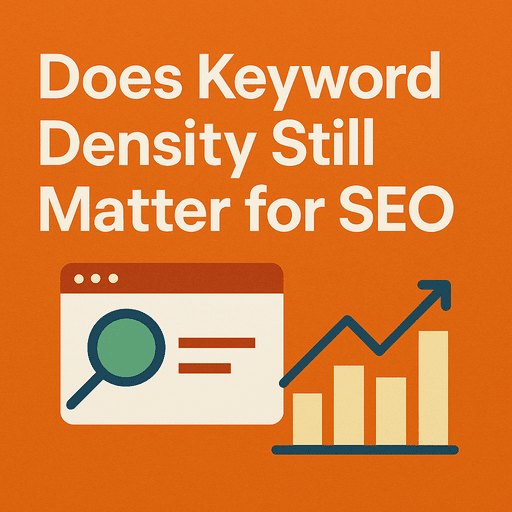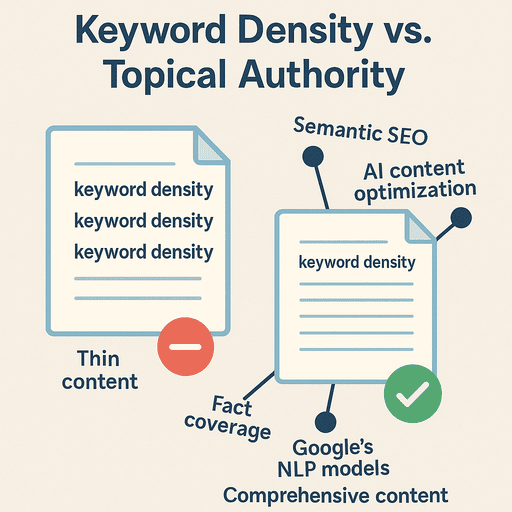Does Keyword Density Still Matter for SEO? (2025 Guide)

Short Answer: Yes, keyword density still matters for SEO, but not in the old percentage-driven way. In 2025, rankings depend on how well you balance keyword optimization, entity coverage, and semantic SEO best practices that prove topical authority.
Introduction
Back in the early days of SEO, keyword density was treated like a formula. Keep it around 2% and you were in the clear. But now we’re in 2025, with AI-driven search and Google Overviews rewriting the playbook. So the big question remains: does keyword density still matter for SEO?
The answer: yes, but differently. Search engines no longer reward mechanical repetition. They evaluate entities, relationships, and how naturally content aligns with user intent. Mention “keyword density” ten times in 1,000 words without adding context, and you’ll get ignored. Mention it in balance while also covering Google Search Console, semantic SEO, AI content, and topical authority, and suddenly your content looks authoritative.
What Is Keyword Density in SEO?
SEO keyword density is the ratio of a keyword’s appearances to the total word count. It’s still calculable: five mentions in a 500-word post equals 1%.
But algorithms aren’t calculators anymore. They’re interpreters. With natural language processing SEO and entity recognition, search systems evaluate meaning instead of just tallying terms. AI content and keyword density get judged by how well the text ties into related concepts, not how many times a phrase repeats.
That’s why density still has a role, but it’s only effective if paired with entity optimization.
Does Keyword Density Still Matter for SEO in 2025?
Yes, but it’s a background player. A certain amount of repetition helps signal relevance. Too much looks like keyword stuffing, which still triggers penalties in Google ranking factors for 2025.
What makes density effective today is how it supports entity alignment. If you’re writing about Honda Ridgeline bed size, you don’t just hammer the keyword. You bring in entities like Honda, pickup truck, truck bed dimensions, and accessories. That tells AI systems you’ve actually covered the subject instead of faking authority with repetition.
Ideal Keyword Density and Entities
If you want a guideline, 1–2% is still safe for your primary keyword. But what matters more is what surrounds that keyword.
Instead of obsessing over a percentage, make sure your content includes:
-
Secondary keywords: “seo keyword density,” “keyword optimization,” “keyword stuffing vs optimization.”
-
Entities: Google, AI Overviews, semantic SEO, NLP, search engines, schema markup.
-
Contextual signals: links, statistics, or related questions people ask.
The combination makes density meaningful.
Keyword Density vs. Topical Authority

Keyword density can show you’re on-topic, but topical authority proves you actually know the subject.
Topical authority develops when your content consistently includes related entities and subtopics. If you’re covering keyword density, AI expects to see connections to things like semantic SEO best practices, AI content optimization, fact coverage, and Google’s NLP models.
Content that weaves these in looks comprehensive. Content that just repeats the main keyword looks thin. Search engines know the difference, and they reward the depth.
Best Practices for Keyword Density and Entities in 2025
If you want to handle keyword density the right way in 2025, focus on these steps:
-
Keep it natural: Keywords should flow, not stick out.
-
Map your entities: Use tools to identify which entities top-ranking pages cover.
-
Balance your density: Keep your primary keyword at 1–2% and distribute secondary keywords where natural.
-
Embrace variations: Synonyms, long-tail phrases, and semantic alternatives keep content rich.
-
Reinforce with structure: Schema markup, internal links, and headings strengthen entity signals.
-
Audit AI drafts: AI tends to over-optimize density, so edit for readability and balance.
FAQ Section
Q1: What is keyword density in SEO today?
It’s still the percentage of a keyword’s use within content, but success now hinges on pairing it with entity recognition and topical depth.
Q2: How much keyword density is good for Google in 2025?
1–2% works, but only if you’ve also included the right entities and related subtopics.
Q3: Does keyword density still matter for SEO?
Yes, as part of a bigger framework of semantic SEO best practices.
Q4: How do AI overviews affect keyword density and entities?
AI Overviews rank content that demonstrates fact coverage. Without entity coverage, keyword density alone won’t cut it.
Q5: How do you avoid keyword stuffing in 2025?
Prioritize readability, spread in secondary keywords, and build content around entities instead of repetition.
Conclusion: From Keywords to Entities
So, does keyword density still matter for SEO? Yes. But it no longer stands on its own. In 2025, density only works when supported by
The shift is clear: search engines reward meaning over mechanics. A balanced approach with keywords in moderation and entities in abundance sets you up for both traditional rankings and visibility in AI Overviews.
If you need help creating SEO content that gets found in Google and AI search, contact me today. I’ll make sure your content is optimized for both keywords and entities, so it performs in 2025 and beyond.

0 Comments Add a Comment?